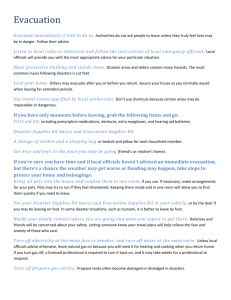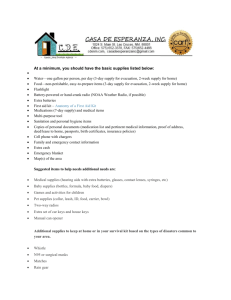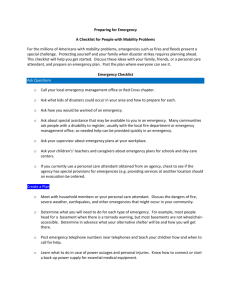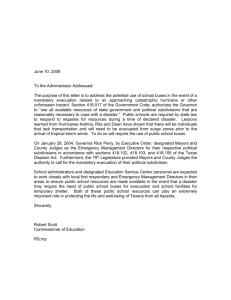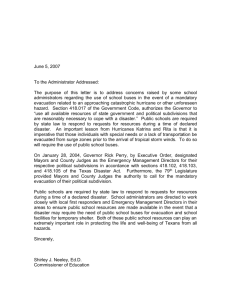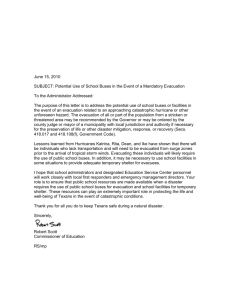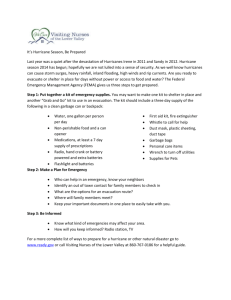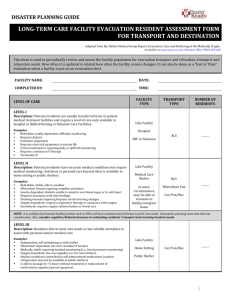File - Cedar Grove Mobilehome Park
advertisement
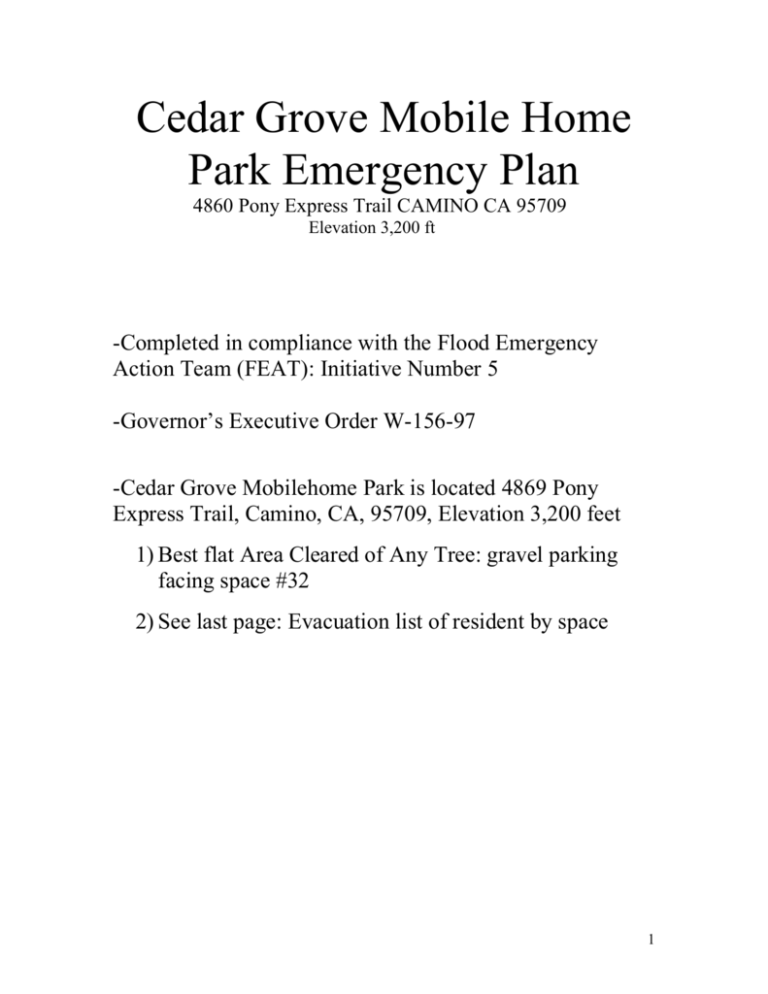
Cedar Grove Mobile Home Park Emergency Plan 4860 Pony Express Trail CAMINO CA 95709 Elevation 3,200 ft -Completed in compliance with the Flood Emergency Action Team (FEAT): Initiative Number 5 -Governor’s Executive Order W-156-97 -Cedar Grove Mobilehome Park is located 4869 Pony Express Trail, Camino, CA, 95709, Elevation 3,200 feet 1) Best flat Area Cleared of Any Tree: gravel parking facing space #32 2) See last page: Evacuation list of resident by space 1 August 2010 Emergency Plans for Cedar Grove Mobilehome Park Introduction The following information is provided as a general guide for developing an emergency preparedness plan for Cedar Grove Mobilehome Park. It contains guidelines and specific information that may be useful in preparing for a natural disaster or man-made emergency. Copy of the plan is readily available by asking the full-time manager, Saul Rodriguez, Space 11 (530-957-2986), or Park Owner, Ami Company (310-697-6966) or on the website: cedargrovemhp.weebly.com, the California Public Utilities Commission (CPUC), the Department of Housing and Community Development (HCD), Fire Department and Legitimes Agencies and Administration. Notice describing to residents how to obtain the plan is posted in the case outside the main door of the office and in the laundry room on bulletin board. Attached is the copy of the notice distributed to residents where information may be obtained from state and local EMERGENCY preparedness agencies. Written verification by park operator that all residents have received notification on how to obtain copy of the present plan. The goal of the emergency plan is to reduce the risk to life, health, and safety of park residents and emergency services personnel. To ensure that all park residents can be evacuated in a safe and timely manner in an emergency, the plan should identify residents with disabilities and health issues that may need assistance during an evacuation. The plan should identify essential evacuation routes that will be used in an emergency situation. Residents must have access to the plan and information on individual emergency preparedness to enable them to take personal responsibility for themselves during an emergency. An important consideration in any emergency is the ability to coordinate with local responding agencies and personnel. It is imperative that residents work in conjunction with and assist emergency response personnel as directed or instructed. 2 Evacuation of a Mobilehome Park: The Disaster Preparedness Emergency Plan Committee (DPEPC) will assist in the evacuation process. Our committee is primarily a phone committee, but in cases where phone service is not available or out of service, the emergency information can be passed house to house. DPEPC will operate under the direction of the manager. DPEPC is responsible for informing each resident of any impending disaster. To conduct training and practice evacuation sessions Acquire and update emergency phone contact lists for next of kin notifications Assess any special needs for fragile, handicapped, elderly or disabled individuals within the park Inform residents of either the possibility of evacuation or of an imminent evacuation of residents during a natural or man-made disaster Inform/train residents on procedures for securing their homes prior to evacuation such as gas shut off, water main shut off, electrical shut off, locking doors and windows, and leaving immediately to pre-determined locations Organize and inform residents of their evacuation route to take in leaving the park in a safe and orderly fashion Secure transportation and coordinate evacuation of park residents who are unable to transport out of the park on their own For fragile, elderly, or disabled residents DPEPC should identify and keep updated records of any special medication, diet, or care information and ensure that they vacate the park with these necessities. People with special needs will also be listed in the office by name, space number and phone number, and contact numbers for next of kin. Park owner, manager and members of the DPEPC being in possession of the list of residents and pets will be during and after disaster able to do the roll count and deliver it to proper authority 3 Planning: Evacuation Plan is as follows: PART I -According to the map attached an in order to avoid two-way traffic, residents must comply with the exit assigned according to their space number. Naturally, if an entrance were blocked all residents would be directed by the DPEPC to the alternate entrance. In the event that all evacuation routes are disabled, one should use the alternate route using the leach-field area (east of large gravel parking lot). That would bring the residents to the gravel road facing Mace Road. (We have an easement for access and utilities for parcel 3 on which the leach fields are located.) -Best safe site of the park for meeting or air lift is, again, the new gravel parking lot facing space 32. In the event of a disaster a) which does not require evacuation of the entire park. Parking lot #1 is the designated site b) Which does require evacuation of the entire park is parking lot of the Mormon Temple ½ mile to the west of Pony Express, better known as The Church of Jesus Christ of Latter Day Saints, 4621 Pony Express Trail, Camino, CA (1/2 mile west of park) PART II: FIRE -Tornado, earthquake and floods are extremely remote disaster risks in comparison to fire – that is accordingly the main and sole focus of the plan -Each resident has been given the “Rules and Regulations” and numerous newsletters in which they are reminded to: -Never accumulate trash, debris, combustible material or liquid and dry wood -Never construct any structure, skirting, or other projects in dry wood -Always secure their water tank and equip their home with a smoke detector -Maintain fire insurance policy on their home 4 Checklist of Emergency Procedures Meet with your family and discuss why you need to prepare for disasters. Explain the dangers of fire, severe weather and earthquakes to children, the elderly, and individuals that may need special assistance. Plan to share responsibilities and work together as a team. The following may be used in creating your own Emergency Response Plan: Draw a floor plan of your residence and mark two escape routes from each room. Install safety features in your home, such as smoke detectors and fire extinguishers. Discuss what to do in an evacuation. Find the safe spots in your home for each type of disaster. Post emergency telephone numbers near the telephone. Instruct household members to turn on a battery powered radio for emergency information. Pick one out-of-state and one local friend or relative for family members to call if separated by disaster (it is often easier to call out-of-state than within the affected area). Teach children how and when to call 9-1-1 and a long distance contact person. Pick two meeting places: 1) a place near your home in case of fire; 2) a place outside your neighborhood in case you cannot return home after a disaster. Keep family records in a water and fire-proof container. Locate the main electric fuse box, water service main, and propane gas main shut off valve to your mobile home. Learn how and when to turn these utilities off. Teach all responsible family members. Keep necessary tools near gas and water shut-off valves. Turn off the utilities only if you suspect the lines are damaged or if you are instructed to do so. If you turn the gas off, you will need a professional to turn it back on. Take a basic first aid and CPR class. Prepare a disaster supply kit. 5 If Disaster Strikes Remain calm and patient. Put your plan into action. Check for injuries; give first aid and get help for seriously injured. Listen to your battery powered radio for news and instructions. Evacuate if advised to do so. Wear appropriate clothing and sturdy shoes. Check for damage to your home - use a flashlight only. Do not light matches or turn on electrical switches, if you suspect damage. Check for fires, fire hazards and other household hazards. If you are remaining in your home, sniff for gas leaks, starting at the hot water heater. If you smell gas or suspect a leak, turn off the main gas valve, open Shut off any other damaged utilities. Clean up spilled medicines, bleaches, gasoline and any other flammable liquid immediately. Remember to: Remember to confine or secure your pets. Call your family contact - do not use the telephone again unless it is a life threatening emergency. Check on your neighbors, especially elderly or disabled persons. Make sure you have an adequate water supply in case service is shut off. Stay away from downed power lines. 6 Fire Safety Fire spreads quickly and the entire structure may rapidly become engulfed in flames. There are steps you can take to minimize the dangers associated with fires and improve your families chances of survival should a fire erupt in your manufactured home. Be sure you have properly operating smoke detectors and fire extinguishers. If one or more of your smoke detectors are battery operated, replace the batteries annually or more often if necessary. An easy to remember schedule is to change your batteries to coincide with daylight savings time. Plan, with the whole family, at least two escape routes from your manufactured home. Practice fire drills regularly, using a smoke detector as a signal to start the drill. Follow your escape plan. Be sure your heating and electrical systems are properly maintained and in good working order. Change the heating filters as recommended by the heater manufacturer. Carefully follow the instructions on all appliances and heating units, taking special care not to overload your electrical system. Be especially careful when displaying your holiday decorations. Keep matches, lighters, and candles away from small children. Children tend to be curious about fire and tend to hide when frightened. Fire drills are most important for children between the ages of 2 and 12 years old. Insure your personal property. Shop around for a company that best meets your needs for renter’s or home owner’s insurance. Store important documents, such as birth certificates, marriage licenses, social security cards, and insurance papers, in a fire-proof box or in the refrigerator, or rent a safety deposit box at your local bank. Make an itemized list of your personal property, including furniture, clothing, appliances, and other valuables. If available, make a video tape of your home and your possessions. Keep the list and/or tape up-to-date and store them along with the other important documents. 7 In Case of Fire Immediately assess the problem (where, extent involved, to assist you in exiting away from the fire source) Know how to use a fire extinguisher Get everyone out of the house immediately Without risk to any person, get pets out of the house Call 9-1-1 or the Fire Department then call the park office (from a neighbors phone) and: 1. Give your name, telephone number you are calling from, park address, space number where the fire is, any helpful locational directions. 2. Describe the type/nature of the fire (gas, wood, chemical, electrical). 3. State that the fire is in a manufactured home and report any known injuries. 4. Turn off the gas and electricity at the home(s) affected. 5. Tell all residents near the fire source to stand ready with water hoses to wet down their homes or adjacent building(s) in case of traveling sparks. 6. Make sure all occupants have left the affected home and immediately let the fire department personnel know if any disabled person(s) or anyone not accounted for and may still be in the residence. 7. Never go back into a burning home. 8. If smoky conditions are present, remember that smoke rises and stay as close to the floor as possible. Before exiting through a door, feel the bottom of the door with the palm of your hand. If it is hot, find another way out. Never open a door that is hot to the touch. 9. Should your clothing catch fire: first *cover your face and mouth*, drop…then roll. Never run. If a rug or blanket is handy, roll yourself up in it until the fire is out. 8 10. If trapped on an upper floor, hang something out of a window to signal rescuers. First Aid Information on first aid can be found in your local phone book or by contacting the American Red Cross. Utilize known persons who are medically trained (such as doctors, nurses, or people medically trained in CPR and first aid) to assist in administering first aid to those injured. If the injured individual(s) are in imminent danger they should carefully be moved to a safe location to administer first aid. In the case where injuries are severe and movement could cause further injuries, do not move the injured. Make the injured person(s) as comfortable as possible and wait for emergency personnel. Before emergencies, prepare a first aid kit. Have the kit in an easy to locate place. Make sure all family members know the location of the kit. Sample First Aid Kit: Sterile adhesive bandages in assorted sizes 2 and 4-inch sterile gauze pads (4-6 each) Hypoallergenic adhesive tape Triangle bandages (3) 2 and 3-inch sterile roller bandages (3 rolls each) Scissors Tweezers Needle Moistened towelettes Antiseptic Thermometer Tongue blades (2) Tube of petroleum jelly or other lubricant Assorted sizes of safety pins Cleansing agent/soap Latex gloves (2 pairs) Sunscreen Aspirin 9 Syrup of Ipecac Activated charcoal (use only if advised by the Poison Control Center) Government and Relief Agencies estimate that after a major disaster, it could take up to three days for relief workers to reach some areas. In such cases, a 72 hour disaster supply kit could mean the difference between life and death. In other emergencies, a 72 hour disaster supply kit means the difference between having a miserable experience or one that’s like a pleasant family camp out. In the event of an evacuation, you will need to have items in an easy-to-carry container like a backpack or duffle bag. Family Disaster Supplies Kit 3-5 gallons of water (one gallon of water per person per day) Method of water purification Food: ready-to-eat canned meats, fruits, and vegetables; canned juices, milk, soup; high energy foods - peanut butter, jelly, crackers, granola bars, trail mix; specialty foods for infants, elderly persons or persons on special diets; comfort/stress foods -cookies, hard candy, sweetened cereals, lollipops, instant coffee, tea bags; vitamins Matches in a waterproof container Second method of starting a fire Tent/shelter Wool-blend blankets or sleeping bags (1 per person) Emergency reflective blanket Lightweight stove and fuel Hand and body warm packs Rain poncho Flashlights with extra batteries, light sticks, lantern with fuel and wicks Tools (pliers, hammer, screw drivers, bolt cutters, pocket/utility knife) Shovel and hatchet or axe Sewing kit 50-foot nylon rope First aid kit and supplies, including burn gel and dressings Bottle of potassium iodide tablets Radio, batteries, and extra batteries Whistle with neck cord Personal sanitation equipment Personal comfort kit (include soap, toothbrush, toothpaste, comb, tissue, razor, deodorant), and any other needed items Extra Clothing (include at least one complete change of clothing and footwear per person per day) extra socks, underwear, hat, gloves, and sturdy shoes Mess kits, paper cups, plates and plastic utensils Cash (at least $20) or traveler’s checks, change for phone calls Non-electric can opener Fire extinguisher: small canister, ABC type Important family papers (copies of birth certificates, marriage licenses, wills, insurance forms, phone numbers, credit card information) Sun block/sun glasses, hat Portable toilet Insect repellent Tape 10 Compass Aluminum foil Signal flare Household chlorine bleach Family Disaster Supplies Kit (continued) Special or prescription medication Baby items - formula, diapers, bottles, powdered milk, medications, and favorite security items Games, books, toys Contact lenses and supplies; a spare set of contacts or glasses if available You should inspect your kit at least twice a year. Rotate food and water every six months. Check children’s clothing for proper fit. Adjust clothing for winter or summer needs. Check expiration dates on batteries, light sticks, warm packs, food and water. Keep a light source stored in the top of your kit for easy access in the dark. Your kit should be in a portable container located near an exit of your house. A large plastic garbage can with a lid makes an excellent storage container. Make sure you have not overloaded your kit as you may have to carry it long distances to reach safety or shelter. You may want to have a backpack or duffle bag for each family member and divide up the rations in the event that family members are separated during evacuation or the disaster. 11 Emergency Contact Information: Western Propane Gas Association 2131 Capitol Ave, Ste 206 Sacramento, CA 95816 (916) 447-9742 American Red Cross Disaster Assistance Division (916) 993-7087 Earthquake Preparedness Center of Expertise Attn: CESPD-CO-EQ 211 Main Street San Francisco, CA 94105-1905 (415) 744-2809 Western Manufactured Housing Communities Association (WMA) 455 Capitol Mall, Ste 800 Sacramento, CA 95814 (916) 448-7002 California Mobile Home Resource & Action Association (CMRAA) P.O. Box 7468 San Jose, CA 95150 (408) 244-8134 National Weather Service (NWS) 3310 El Camino Ave, Room 226 Sacramento, CA 95821 (916) 979-3041 12 Agencies and Resources Local radio station frequencies: KYCJ 88.3 FM KBYN 95.9 FM KNCO 830 AM KFSG 1690 AM The following is a partial listing of contact agencies that supplied information for this guidance and may be able to provide additional emergency information. State-Federal Flood Operations Center (800) 952-5530 Office of the State Fire Marshal (916) 445-8200 Department of Water Resources (Flood Forecasting) (800) 952-5530 Department of Housing & Community Development (HCD) Division of Codes and Standards, Manufactured Housing Section (916) 445-3338 HCD Northern Area Office 9342 Tech Center Dr. Suite 550 Sacramento, CA 95826 (916) 255-2501 California Emergency Management Agency (Cal EMA) Counties of Nevada, Placer, Yolo, El Dorado, Sacramento, Amador, Calaveras, Alpine, San Joaquin, Stanislaus, and Tuolumne (916) 845-8470 13
